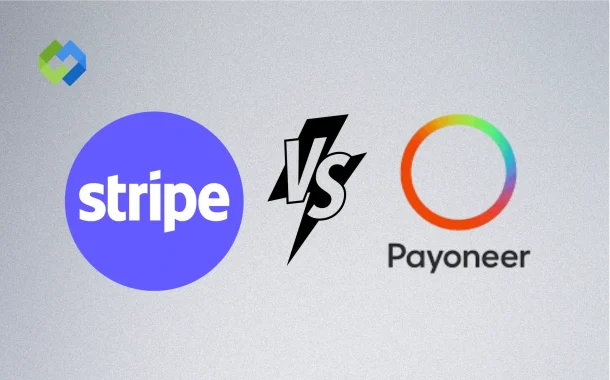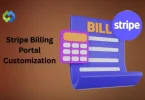Ecommerce sellers need fast and safe ways to receive money. A trusted payment system helps avoid delays, high fees, and technical issues. Customers also feel secure when paying through known services. A good payment tool can handle different currencies, protect against fraud, and support global transactions.
Table of Contents
Table of Contents
Core Features of Stripe and Payoneer
Stripe
- Lets you accept credit cards, digital wallets (like Apple Pay and Google Pay), and bank transfers.
- Supports one-time payments, recurring billing, and subscriptions.
- Offers invoicing tools and custom checkout flows using APIs.
- Provides real-time analytics and detailed financial reports.
- Includes fraud detection through Stripe Radar.
- Easily integrates with ecommerce platforms like Shopify and WooCommerce.
- Ideal for online businesses that want full control over payments.
Payoneer
- Lets you receive payments from global marketplaces like Amazon, Fiverr, and Upwork.
- Provides virtual bank accounts in multiple currencies (USD, EUR, GBP, etc.).
- Supports cross-border payments and international client transfers.
- Allows local bank withdrawals and provides a prepaid Mastercard.
- Does not offer checkout solutions but is strong in receiving global funds.
- Easy to manage funds through a simple dashboard.
- Best for freelancers, remote workers, and marketplace sellers.
Ease of Use and Setup for Ecommerce
Stripe
Stripe is easy to set up for ecommerce businesses that run their own websites. Signing up takes just a few minutes. You enter your business and bank details, and Stripe handles the rest. The dashboard is user-friendly and shows your earnings, customer payments, refunds, and reports in one place.
Stripe also gives real-time insights to track sales performance. It connects smoothly with major ecommerce platforms like Shopify, WooCommerce, and BigCommerce. If you have a developer, Stripe’s API lets you create a fully customized checkout experience. It’s ideal for businesses that want full control over the customer payment process.
Payoneer
Payoneer is designed for freelancers, marketplace sellers, and businesses that deal with global clients. You can create an account quickly by submitting your details and verifying your identity. Once set up, you get access to virtual bank accounts in different currencies like USD, EUR, and GBP. The dashboard is easy to use and shows your balances, payment history, and withdrawal options clearly.
Payoneer supports payments from platforms like Amazon, Fiverr, Upwork, and more. It’s great for cross-border transactions and lets you withdraw funds to your local bank account or use the Payoneer card. It’s a solid option for sellers working internationally without a personal website.
Integration with Ecommerce Platforms
Stripe
Stripe works very well with ecommerce platforms. It has built-in support for popular services like Shopify, WooCommerce, Wix, BigCommerce, and Squarespace. You can easily connect Stripe without needing to code. Most platforms offer a Stripe plugin or built-in feature that lets you start accepting payments quickly.
Stripe also supports subscriptions, one-time payments, and discount codes. If you want more control, developers can use Stripe’s API to build a custom checkout. Stripe is best for store owners who run their own website and want direct integration.
Payoneer
Payoneer is not made for direct integration with ecommerce store builders. Instead, it works with global marketplaces like Amazon, Walmart, Etsy, Fiverr, and Upwork. These platforms allow you to link your Payoneer account to receive earnings. You don’t need to install any plugin or set up a payment gateway. Payoneer acts as a payment receiving service, not a checkout tool. It’s best for sellers who work through third-party marketplaces rather than running a personal online store.
Payout Methods and Speed
Stripe
Stripe sends payments directly to your bank account. After a customer pays, Stripe holds the money for a short time. This is usually between 2 to 7 business days depending on your location and account activity. Once processed, the funds are automatically transferred.
You can choose how often you want to receive payouts, such as daily, weekly, or monthly. Stripe supports multiple currencies, making it easier to handle global payments. However, if you are a new user, your first few payouts might take a bit longer to reach your account.
Payoneer
Payoneer gives you more control over how you receive your money. You can withdraw funds to your local bank account in your own currency. It also gives you virtual bank accounts in USD, EUR, and other major currencies, so you can receive international payments easily.
Transfers usually take 1 to 3 business days. You can also use a Payoneer card to spend or withdraw cash. This flexibility makes it useful for global sellers and freelancers.
Fees and Pricing Structure
Stripe
Stripe charges a standard fee of around 2.9% plus a small fixed amount (like $0.30) per successful card transaction. These fees apply to most local credit or debit card payments. If your customer pays using an international card or in a different currency, Stripe adds an extra fee, usually about 1%. There are no setup, monthly, or hidden charges.
Stripe also offers optional features like recurring billing, invoicing, and fraud protection through Stripe Radar. These may come with additional costs if you choose to use them. All pricing details are available in your dashboard, making it easy to monitor expenses. Stripe’s pricing is straightforward and works well for businesses with consistent transaction volumes.
Payoneer
Payoneer has a flexible fee structure that depends on how you receive and withdraw funds. Receiving money from other Payoneer users is free. If you get paid by clients via credit card or bank transfer using Payoneer’s request a payment feature, fees usually range from 1% to 3%. Payments received through the Global Payment Service may also have a fee around 1%.
Withdrawing money to your local bank has a small flat fee, and currency conversions typically include a 2% markup above the mid-market rate. There are no monthly charges unless your account stays inactive for 12 months. Payoneer’s model is more focused on cross-border payments, and it gives global sellers more control over how they manage funds.
Global Support and Currency Options
Stripe
Stripe supports businesses in over 45 countries and accepts payments from all over the world. Customers can pay using cards, wallets, and local bank methods. Stripe also supports multi-currency pricing, so you can list products in your buyer’s local currency. You’ll receive the funds in your default currency after a small conversion fee. This helps online stores sell globally without much setup. Stripe is ideal for ecommerce sellers who want a smooth global checkout experience.
Payoneer
Payoneer works in over 190 countries and is built for international payments. It gives you virtual bank accounts in USD, EUR, GBP, and more. You can receive payments like a local business in those regions. When you withdraw to your local bank, Payoneer converts the currency for you. The platform supports cross-border transactions well and is useful for marketplace sellers, freelancers, and service providers dealing with international clients.
Conclusion
Stripe and Payoneer both help ecommerce businesses get paid. Stripe is great for online stores that need full control over payments. It works well with websites and offers many features like subscriptions and custom checkouts.
Payoneer is better for sellers on global marketplaces. It helps you collect payments from platforms like Amazon and Upwork. You can withdraw money easily in your local currency. Choose Stripe if you run your own website. Go with Payoneer if you work with global clients or marketplaces.














